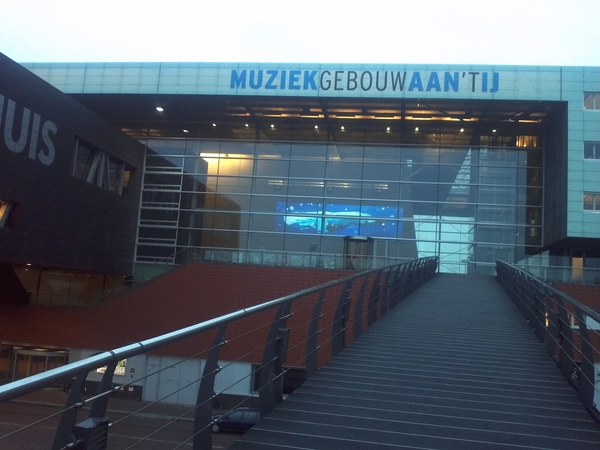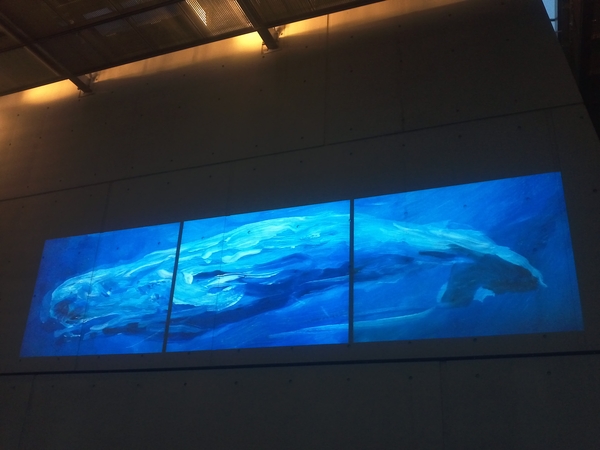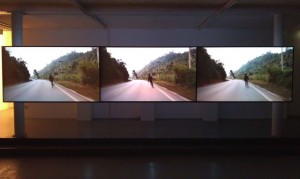HDSync “Still in Amsterdam” 1.3
News
Download zoneThis release makes PGM broadcast more stable by updating the 0mq library to version 2.2 and libpgm to version 5.2.122. The handshake now works better in different network conditions.
Thanks go to Christian Walter for his experienced troubleshooting and for hiring our services, which basically makes this bugfix release possible.
Also through 2012 HDSync was customized for more stability and adopted by our friend Michael van Rosmalen for a prestigious exhibition:
“International Tour After History: Alexandre Kojève as a Photographer” (distributed by BAK, basis voor actuele kunst, Utrecht)
HDSync was touring around the world in this exhibition. It consist of up to 11 players all synced playing a slide show imitating old slide projectors, including the click-slide-clunk sound coming from the projectors build in speakers. Venues and Dates:
- Gwangju Biennale 2012, Gwangju, 7 September-11 November 2012
- OCAT, Shenzhen, 21 September-16 November 2012
- Palais de Tokyo, Paris, 15 October-6 January 2013,
- CUNY, New York, April-May 2013
Interesting facts
The record number of synced audio/video channels using HDSync is up to 37 different channels: the Ambarella video wall
HDSync is portable and can be compiled and used on different hardware: its code is written C/C++ that compiles for targets as ARM, MIPS and x86 platforms.
The digital video syncstarter software was developed between 2006 and 2012 in the Montevideo/NIMk Artlab. In 2013, as a consequence of cultural funding cuts in the Netherlands, the Artlab has been shut down and the whole institute has been closed after 35 years of activity. Since then, the development of HDSync is not publicly funded anymore. For further development, the Syncstarter project needs your support.
HDSync makes heavy use of PGM multicast (RFC 3208), which is basically UDP traffic, to synchronise multiple units on the same local network. In order for it to work, make sure your LAN switch does not block UDP multicast: old hubs work best.
HDSync reaches a fairly precise frame synchronization, down to a randomly occurring error rate of 3 frames out of sync, which is hardly noticeable in most footage. 1 to 1 frame synchronisation is impossible to achieve with our software.
It is necessary to add 5 seconds of black in front of any synced audio/video footage in order to avoid an irregular blink at the start of every loop.
Syncstarter community
Discussion mailinglistWe are grateful the encouraging feedback we receive from users of our software all over the world, last but not least John Koczera from the Harvard University VES Department (Visual Environmental Studies) says:
I successfully introduced this software to some old players I found online. I then made this software, along with my version of documentation available to our students on our media networks. The response was great. We had several successful artworks shown this past spring at our end of year opening.
Thanks for letting us know, cheers!
read moreHDSync “Montevideo” 1.1
A new version of HDSync is out: 1.1 codename “Montevideo”.
This release fixes the “static” network configuration to let nodes handshake on a local network without the need for a DHCP server.
HDSync is hereby declared stable software, frame synchronization is below 3 frames error and hardly visible to human eye.
Please note that, as a consequence of cultural funding cuts in the Netherlands, this development program is being shut down and the whole Montevideo/NIMk institute will be closing by the end of the year, after more than 30 years of activity.
The Syncstarter development will survive as free and open source software, hoping it can benefit the video art community at large, keeping the Montevideo / Time Based Arts tradition alive.
Join us on Thursday 31 May in Amsterdam, Keizersgracht 264, at 17:00 where we’ll give a last demonstration of this software at Montevideo/NIMk.
To stay in touch in the future be welcome to join the syncstarter mailinglist.
read moreHDSync “Ambarella” 1.0
A new version of HDSync is out: 1.0 codename “Ambarella”.
This release can synchronise the playback of multiple channels, virtually unlimited, so far the known record is set to 37.
This release consists of a full rewrite of HDSync in C language, eliminating most of the shell scripted interaction and condensing operations into a single process.
The result of this rewrite is more stability (the 4 hours freeze is now solved!), visibly lower latency of operations, more control over network handshake and synchronization – plus we’ve made the HDSync software easy to port on more platforms.
Empirical tests show way better synchronization (close to frame precision) and very low margin of error in re-syncing after loops (still some de-sync occurs from time to time when using short clips). Please note that now it is necessary to add 5 seconds of black infront of the synced videos, in order to avoid an irregular blink at the start of every loop.
HDSyn can synchronise the playback of multiple channels, virtually unlimited.
The record so far is set to 37 channels by the Ambarella Video Wall that also gives the name to this release:
Visit HDSync homepage to know more about it and download the software.
read more
HDSync “Dried sunflower” 0.6.1
A new version of the source (and binary build) of HDSync is out: 0.6.1 codename “Dried sunflower”.
This release includes a contribution by Michael van Rosmalen to improve stability of long term playback.
A parallel watchdog process can be configured, fixing a freezing bug that occurred randomly after running over a day.
It also enhances logging, adds the option for manual network configuration and increases the accuracy of sleep timing adjustment to micro-seconds.
Download
As usual you can download the latest version of HDSync sourcecode as well MIPSEL binary builds (WDLXTV app.bin)
Feel free to subscribe our mailinglist to stay in touch and discuss further development.
News
This version of HDSync, including the recent fixes, is being useful for the New York State Museum, where it is running inside the exhibition Reflecting on September 11, 2001 (with thanks to Nicholas Lue for testing and bug hunting) and for the BAK Utrecht where it is deployed to show the installation “Route 3” by David Kelley and Patty Chang.
read more
HDSync 0.6 “Sunflower” released
A new version of the source (and binary build) of HDSync is out: 0.6 codename “Sunflower”.
Here below a summary of changes:
- Improved stability
- Fixes to the looping of videos
- Fixes to network handshake
- Documentation updates
- New website, mailinglist – and here we are :)
as usual you can download the latest version of HDSync sourcecode as well MIPSEL binary builds (WDLXTV app.bin)
This release gets us to a good point, but HDSync still is in a BETA stage of development and we don’t have yet 100% precise frame sync.
Also there is a problem reported by many users, that the boxes freeze after about 4 to 6 hours of syncstarted loops, this is a problem we will address in the coming releases and for which there seems to be already a temporary fix.
Hence, the primary development goals towards 1.0 are: making the loop more steady (avoid freezes) and making the sync frame precise. In particular for the frame precision sync I’m planning to rewrite the network handshake and sync mechanism: while it is currently using a shell script and code from GNU netcat, I expect to lower the latency adopting the 0mq library.
Feel free to subscribe our new mailinglist to stay in touch and discuss further development.
read more




